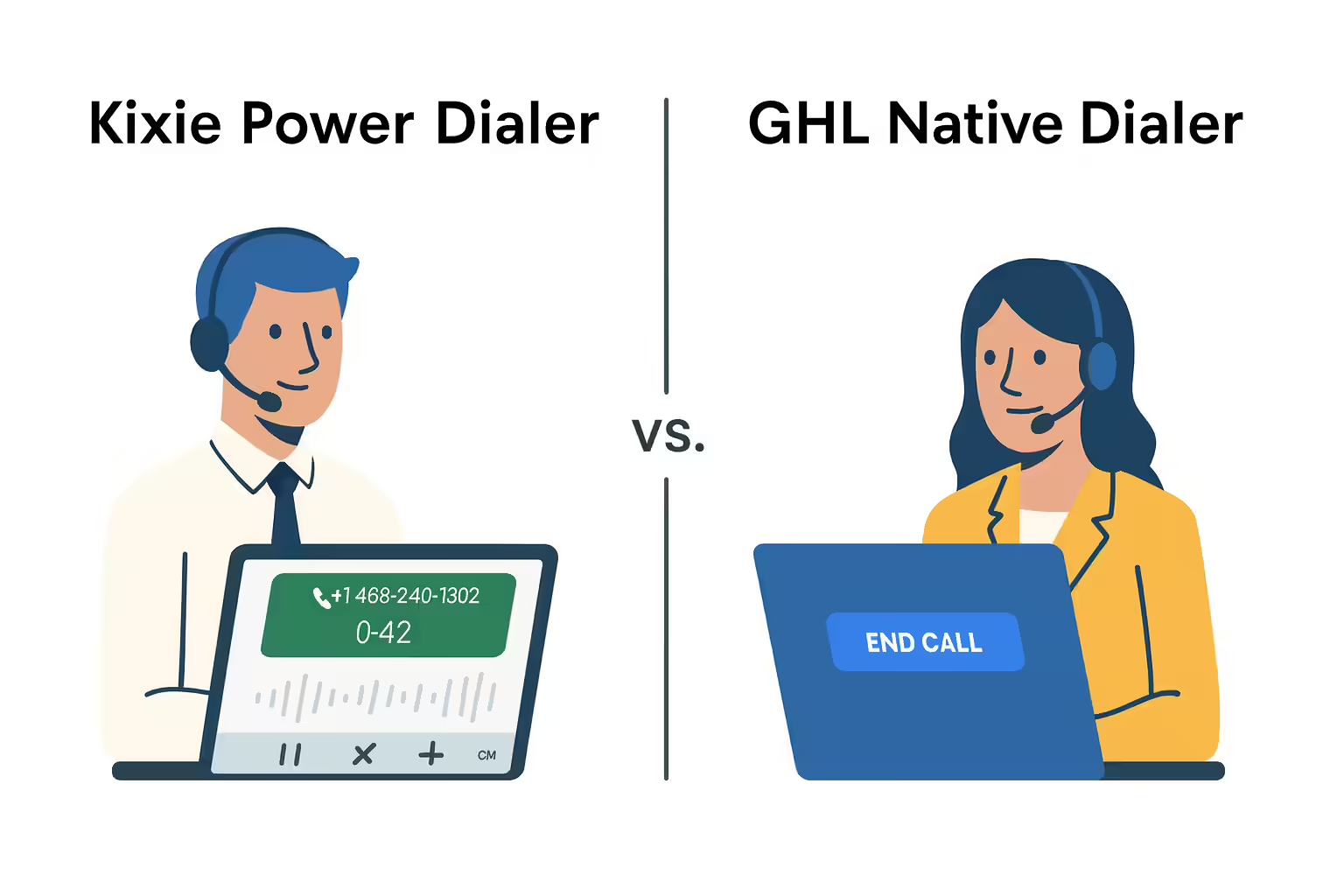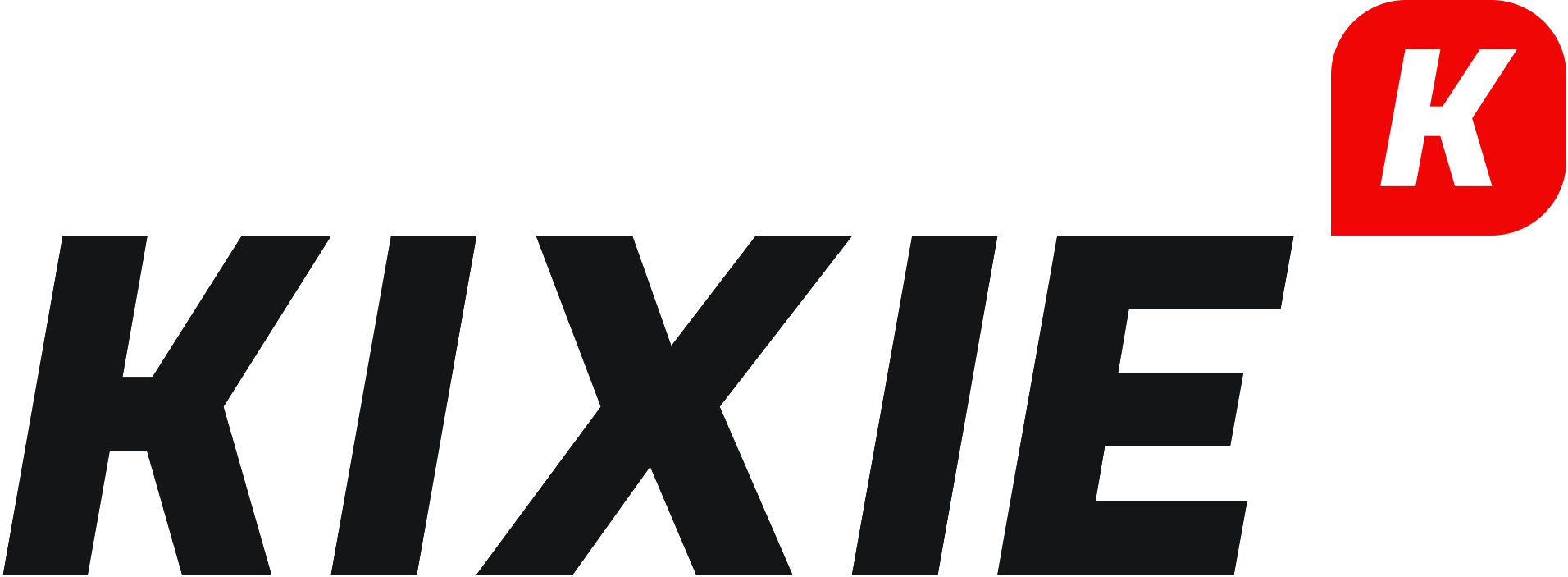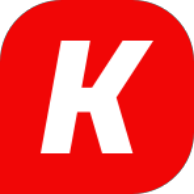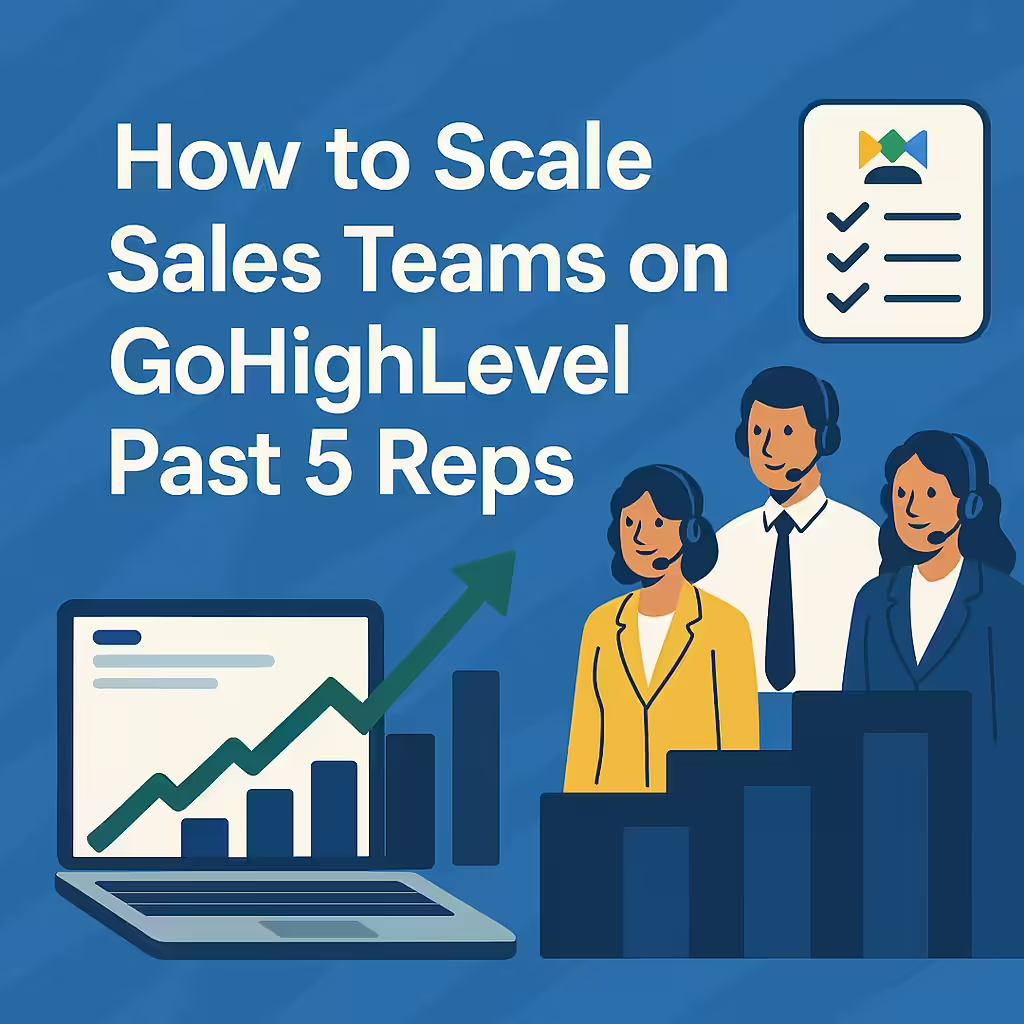TL;DR: GoHighLevel Scaling Failures and Kixie Solution Summary
GoHighLevel (GHL) fails to scale sales teams past five reps due to a "Scaling Paradox" rooted in its architecture, which is designed for marketing automation, not high-volume, team-based sales. This creates three primary failures: 1) The CTI Failure, where GHL's shared number pool causes "Spam Likely" flags, low answer rates, and poor call quality; 2) The Operational Failure, where GHL's "flat architecture" lacks team-based lead routing, preventing "speed-to-lead" and causing leads to "rot"; and 3) The Management Failure, characterized by an inability to report by team, forcing managers into "Spreadsheet Hell". The solution is integrating Kixie as a "scaling package". Kixie solves the CTI failure with an enterprise-grade system using dedicated numbers and "ConnectionBoost" AI Local Presence. Kixie solves the operational failure by adding a "Team Layer" via "Ring Groups" for "Linear Round Robin" routing. Kixie solves the management failure with advanced analytics, including a "Teams" filter, live leaderboards, disposition reporting, and a coaching toolkit (Live Call Listen, Whisper, Barge).
Table of Contents
Why Your GoHighLevel Setup Is Breaking at 5 Reps
GoHighLevel (GHL) is an exceptional platform for marketing automation, funnels, websites, and calendars. For a small team of one to three representatives, its all-in-one simplicity is a powerful asset, centralizing marketing, sales, and communication in one dashboard.
However, many agencies and sales organizations experience a "Scaling Paradox": the moment their sales team grows to five or more reps, the all-in-one platform transforms from their primary asset into their primary bottleneck.
This "functional brick wall" is not imagined; it is a predictable outcome.
Managers encounter "continuous roadblocks" that are symptoms of a deeper, architectural misalignment. These roadblocks manifest in three distinct failure points:
- The CTI Failure: "My reps' calls are consistently flagged as spam," or "Call quality is choppy and unreliable".
- The Operational Failure: "I have no way to route a new lead to the next available rep; hot leads are rotting in one person's queue while other reps are idle".
- The Management Failure: "I have to export data to a spreadsheet just to see which rep made the most calls, and I have no way to report on my team's performance".
This report will analyze these three failures. The central argument is that these roadblocks are not bugs to be fixed but are structural consequences of GoHighLevel's core architecture.
GHL was designed for marketing automation and managing separate agency sub-accounts , not for the hierarchical, high-volume, real-time demands of a scaling sales team operating within a single sub-account.
The solution is not a disruptive and costly migration to a new CRM. The solution is to integrate Kixie as the "scaling package" that bolts onto GoHighLevel, providing the three missing layers the platform lacks:
- Enterprise-Grade CTI: For stable, high-deliverability calling.
- The "Team Layer": For intelligent, group-based lead routing.
- Advanced Analytics & Coaching: For true, real-time performance management.
This "mile-wide, inch-deep" approach is GHL's greatest strength for marketing, allowing it to replace 10+ tools. However, this means it cannot also dedicate the resources for the deep, capital-intensive infrastructure required for enterprise-grade telephony. A scaling sales team, therefore, must solve this by integrating a specialized, best-in-class tool.
Analyzing GoHighLevel's Native CTI at Scale
The first and most critical roadblock a scaling sales team encounters with GoHighLevel (GHL) is the phone system itself.
If sales representatives cannot reliably connect with prospects, no amount of automation in the funnel matters.
The Stability and Call Quality Problem for GoHighLevel Sales Teams
The first symptom of a CTI system under strain is call quality degradation.
GoHighLevel's (GHL's) own support documentation acknowledges "bad call quality," which includes choppy audio, one-way audio, and dropped calls, as a common issue for users.
The officially documented causes for this poor VoIP performance are primarily diagnosed as user-side issues: "internet instability," "device interference," "network misconfiguration," and bandwidth consumption from other applications. This analysis subtly shifts the burden of a stable connection onto the end-user's local network.
A truly robust, enterprise-grade CTI platform is designed to be resilient despite network imperfections.
Its infrastructure must be built for mission-critical communication, not just convenience.
For example, Kixie's system, an integration designed to solve GHL's scaling issues, includes a failover solution called "Kixie Connect," which allows a user experiencing bad call quality to instantly re-route calls through their cellular network while still logging all activity and data to the CRM. GHL's lack of a stable failover mechanism demonstrates its infrastructure is not "mission-critical" ready for a high-volume sales floor.
The "Spam Likely" Crisis for GoHighLevel Sales Reps
Stability is the first issue for teams using GoHighLevel's (GHL's) native phone system, but call deliverability is the crisis that cripples scaling teams.
Agencies using GHL's native calling system report losing "60-80% of potential conversations" due to abysmal answer rates.
The root cause of this deliverability crisis is GHL's reliance on a shared phone number infrastructure. Because this number pool is used by many GHL users, a single bad actor (or simply another high-volume agency) can poison the reputation of the entire pool, causing all other users' calls to be flagged as "Spam Likely". This "destroys call deliverability" and renders a sales team operationally inert.
GoHighLevel has attempted to address this with the release of a native "Local Presence Dialing" feature, which automatically matches the outbound caller ID to the recipient's area code. However, GHL's own user-feedback forum reveals this feature is built on the same faulty foundation. Users in the forum are "desperately" requesting the ability to purchase private numbers to "manage carrier reputations better," correctly identifying that a Local Presence feature is useless if the underlying numbers are shared and have a bad reputation.
This confirms the structural flaw: GHL's native CTI is incapable of protecting a user's caller ID reputation, which is the single most important asset for a scaling outbound sales team.
The Kixie CTI Solution for GoHighLevel Sales Teams
Kixie integrates with GoHighLevel (GHL) to replace GHL's fragile, shared phone infrastructure with an enterprise-grade CTI engine designed for high-volume sales.
Infrastructure: Kixie provides dedicated, carrier-optimized phone numbers. This is the direct, structural solution to GHL's shared number pool issue, a flaw identified by GHL's own users. It gives each business control over its own caller ID reputation.
Answer Rates: Kixie features "ConnectionBoost," an AI-powered Local Presence feature that not only dynamically matches area codes but also actively manages number reputation to avoid spam flags. This is not a simple area-code match; it is an active reputation defense system. The results are immediate, with agencies reporting a "200-300% improvement" in answer rates in the first week.
Productivity at Scale: Kixie is built for the workflow of a scaling sales team.
It provides a multi-line power dialer that can dial up to 10 lines simultaneously, allowing a team to contact 10x more leads. It also features 1-click automated voicemail drops, saving reps hours of repetitive work. GoHighLevel has no native equivalent to these essential sales productivity tools.

CTI and Dialer Infrastructure Comparison
| Feature | GoHighLevel (Native) | Kixie (Integrated Solution) |
|---|---|---|
| Phone Number Infrastructure | Shared Number Pool | "Dedicated, Optimized Numbers" |
| Call Quality & Stability | Prone to Jitter/Drops | "Stable VoIP w/ ""Kixie Connect"" Cellular Failover" |
| Local Presence Dialing | Basic Area-Code Matching (on shared numbers) | "AI-Powered ""ConnectionBoost"" (on dedicated numbers)" |
| High-Volume Power Dialer | Not Available | Yes (Up to 10-Line Dialer) |
| Voicemail Drop | Manual Only | Yes (1-Click Automated Drop) |
Solving GoHighLevel's "No Teams" Architectural Gap
Beyond CTI (phone system) issues, a manager using GoHighLevel (GHL) encounters the next major roadblock as their team scales: GHL's architecture cannot manage a team of reps.
This is the "glass ceiling" that scaling sales organizations hit.
GoHighLevel's Lead Routing Black Hole and "Speed-to-Lead" Collapse for Sales Teams
The core architectural flaw preventing team management in GoHighLevel (GHL) is that its user structure is "completely flat". It was built for an agency to manage multiple, separate client sub-accounts.
It was not built to manage a hierarchical team of reps (e.g., SDRs, Closers, Support) all working together within a single sub-account.
As a result, GHL "cannot route leads to a group, only to a specific rep". This creates "uneven lead distribution" and has catastrophic consequences for "speed-to-lead," the single most important metric in sales.
Consider this causal chain:
- A new, high-intent lead (e.g., from a "Form Submitted" trigger) enters a GHL workflow.
- That workflow can only assign the lead to one specific user (e.g., "Rep 3").
- If "Rep 3" is on a demo, at lunch, or on another call, that hot lead rots.
- This creates a single point of failure for the entire lead flow.
- Meanwhile, "Rep 1" and "Rep 2" are idle, but GHL's architecture cannot pivot and send them the lead.
GoHighLevel's native architecture guarantees lead decay and lost opportunities as a team scales, simply because the statistical probability of the one assigned rep being busy is too high.
The Kixie "Team Layer" Solution for GoHighLevel
Kixie integrates with GoHighLevel (GHL) as the "Team Layer" that GHL's flat architecture is missing. It provides the necessary tools to build a sophisticated, team-based routing system.
-
1Step 1: Build the "Team" Entity.
Inside Kixie, a manager creates a "Ring Group" and names it (e.g., "SDR Team" or "Closer Team"). This Ring Group becomes the functional "team container" that GoHighLevel (GHL) natively lacks.
-
2Step 2: Solve "Fair Distribution."
When creating the Ring Group, the manager selects the "Linear Round Robin" setting. This automatically routes the next incoming call to the next agent in line, ensuring fair, even, and instant lead distribution.
This one feature directly solves the "single point of failure" problem.
-
3Step 3: Automate Outbound Lead Routing.
The system connects GoHighLevel (GHL) workflows directly to Kixie teams.
In the GHL Workflow Builder, the trigger is set (e.g., "Form Submitted"), and the manager adds the native Kixie action "Add Contact to PowerList". That PowerList is assigned to the entire "SDR Team" Ring Group. The first available rep on the team can then call that new lead, ensuring speed-to-lead is measured in seconds, not hours.
-
4Step 4: Intelligent Inbound Lead Triage.
Kixie's Automatic Call Distribution (ACD) can read GoHighLevel's (GHL's) database in real-time as a call connects. This allows managers to build a sophisticated triage system that is impossible in GHL alone.
For example:
IF GHL Tag = "VIP Client" $\rightarrow$ ROUTE TO Ring Group "Senior Support".
IF GHL Deal Value > $5,000 $\rightarrow$ ROUTE TO Ring Group "Closer Team".
This integration creates a bi-directional workflow ecosystem. GHL workflows can trigger Kixie actions (like adding a contact to a PowerList). But, more powerfully, Kixie actions can trigger GHL workflows.
A sales rep can finish a call in the Kixie dialer and select a "Call Outcome" (Disposition) like "Meeting Booked". This action can instantly trigger a GHL workflow that sends the appointment confirmation email and moves the opportunity to the "Meeting Set" stage in the GHL pipeline. The rep performs one action (dispositioning the call), and the entire sales and marketing operation is automated around it.
GoHighLevel's "Reporting Blind Spot" for Sales
The third major scaling roadblock for sales teams on GoHighLevel (GHL) is management: managers are "flying blind".
This is because GHL's reporting infrastructure is not built for sales management.
The "Spreadsheet Hell" Diagnosis for GoHighLevel Sales Managers
The "most significant gap" in GoHighLevel (GHL) is its "inability to report on sales performance by team ". Because of its flat architecture, managers can only pull data for individual users.
This forces them to "export and manually calculate team metrics," which is a "Spreadsheet Hell" that scaling managers live in.
This is not a minor oversight; it is the most common complaint from frustrated GHL power users.
The GHL Ideas forum is filled with managers begging for this basic functionality.
One user writes, "it's crazy that there is not a tab for me to click that says 'I have made X dollars this month'". Another requests the simple ability to "Allow to choose the pipeline and/or owner (sales rep) in custom metrics for reporting". This confirms GHL's awareness of, and failure to solve, this core management problem.
This gap exists because GHL's native reporting is fundamentally misaligned with a sales manager's needs.
It is built to track marketing campaign metrics, not sales team metrics.
GHL's own documentation highlights its reporting tools for "Lead Source Tracking," "Funnel Analytics," and "Email and SMS Metrics". These are marketing KPIs.
A sales manager needs sales activity KPIs (Dials, Connections, Talk Time) and sales outcome KPIs (Dispositions like "Meeting Booked," "Wrong Number"). GHL's reporting is built to answer, "Which ad campaign generated the most leads?"
It cannot answer, "Which sales team is the most efficient at converting those leads to meetings?"
The Kixie Analytics Solution for GoHighLevel Teams: The "Missing Team Filter"

Kixie's analytics dashboard is built for sales managers and, when integrated with GoHighLevel (GHL), provides the "CRUCIAL filter" that GHL lacks: the "Teams" filter.
Historical Team Reports: A manager can go to "Agent Reports," filter by a "Sales Team" (a Kixie Ring Group), and instantly see aggregated totals for "Total Outgoing Calls," "Total Connections," "Average Talk Time," and "SMS Volume". This single feature eliminates "Spreadsheet Hell".
Real-Time Team Management: GoHighLevel (GHL) has no live activity dashboard.
Kixie provides "Live Sales Leaderboards" that can be put on an office TV to gamify performance. These leaderboards can also be filtered by "Team", allowing a manager to see, in real-time, who is active and who is idle.
Outcome (Disposition) Reporting: Kixie's dialer logs a "Call Disposition" for every call. Managers can then run reports sorted by disposition to see which reps are booking the most meetings, and which reps simply have high call volume with no results.
This integrated data allows a sales manager to finally build a complete KPI funnel and diagnose their real problems.
The management view is transformed from a "black box" into a visible, data-driven causal chain:
[GHL] Leads In $\rightarrow$ [Kixie] Total Dials by Team $\rightarrow$ [Kixie] Total Connections by Team $\rightarrow$ [Kixie] "Meeting Booked" Dispositions $\rightarrow$ [GHL] Deals Won.
The manager can now identify the cause of a performance issue: "Our connection rate is only 10% (a CTI/list problem)," or "Our connection-to-meeting rate is 5% (a pitch problem)".
This level of granular diagnosis is impossible in native GHL.
Team Management and Reporting Comparison
| Feature | GoHighLevel (Native) | Kixie (Integrated Solution) |
|---|---|---|
| Lead Routing to Teams | No (User-level assignment only) | Yes (ACD reads GHL tags to route to Ring Groups) |
| Fair Lead Distribution | No (Manual or basic round-robin) | "Yes (""Linear Round Robin"")" |
| Performance Reporting by Team | "No (User-level only, requires manual export)" | "Yes (""Team"" filter in all reports)" |
| Real-Time Team Leaderboard | No | Yes (Team-filterable Live Leaderboard) |
| Call Outcome (Disposition) Reporting | Basic | "Advanced (Custom, reportable, and triggers GHL workflows)" |
Tools to Improve Sales Rep Performance on GoHighLevel
Scaling a sales team is not just about quantity (more reps, more leads); it is about quality (better reps). GoHighLevel (GHL) is a powerful marketing automation platform, but it has no tools for managing the human element of a sales team.
Kixie, an integration for GHL, is built for sales managers and provides a full suite of tools to improve rep quality and shorten ramp time.
The Kixie Coaching Toolkit for GoHighLevel Sales Reps
Kixie's coaching toolkit provides the quality assurance layer necessary to de-risk a team's expansion, transforming scaling from a high-risk gamble into a manageable, data-driven process.
This is the most powerful component for scaling. GoHighLevel (GHL) has no equivalent.
- Live Call Listen: Managers can silently listen in on any rep's call to assess performance.
- Whisper: Managers can speak directly to their rep during a live call without the prospect hearing to provide real-time advice (e.g., "Ask about their budget now.").
- Barge: Managers can "take over" the call to "rescue a green sales agent" and save a deal.
- Call Recording: All calls are automatically recorded and logged to the corresponding GoHighLevel (GHL) contact record.
- Conversation Intelligence: Kixie provides AI-powered call transcription and "Sentiment Analysis". This allows managers to quickly review call quality, rep talk-time, and customer reactions without having to listen to hours of recordings.
When a manager hires five new reps, the "Coaching Gap" becomes a critical liability.
In native GoHighLevel (GHL), the manager has no way to know if these reps are performing.
They cannot listen to their calls or easily see their activity.
With the Kixie integration, that same manager can, on Day 1, use the Live Call Board to see the new reps are active, "Listen" to their first calls, "Whisper" a critical tip to build confidence, and review their AI Sentiment Analysis that evening.
Stop "Graduating" from GoHighLevel. Upgrade Your Sales Teams Instead.
The "Scaling Paradox" is real. The "continuous roadblocks" managers face when scaling a sales team on GoHighLevel (GHL) are not imaginary.
They are the predictable and logical consequence of GHL's "mile-wide, inch-deep" architecture, which is optimized for marketing automation, not high-volume, team-based sales.
This structural reality forces many successful, scaling agencies to have the "painful 'we've outgrown GHL' conversation". They believe their only option is a "disruptive and expensive migration to platforms like HubSpot or Salesforce".
This is the wrong move. "You don't need to 'graduate' from GHL. You just need to upgrade it".
Kixie, an integration for GHL, is the "Team Layer" that "bolts-on" the missing sales infrastructure.
The integration is native, seamless, and can be set up in minutes without complex code.
By integrating Kixie with GHL, managers solve all three scaling failures simultaneously:
- The CTI Failure is solved with dedicated numbers and AI-powered Local Presence, ending the "Spam Likely" crisis.
- The Operational Failure is solved with Ring Groups and intelligent routing, ending the "rotting leads" problem.
- The Management Failure is solved with team-based reporting and live coaching, ending the "Spreadsheet Hell" and "black box" management.
Stop exporting to spreadsheets. Stop letting hot leads rot. Stop planning a costly CRM migration.
Integrate the Kixie "scaling package" and turn GoHighLevel into the high-performance sales platform a scaling team truly needs.



